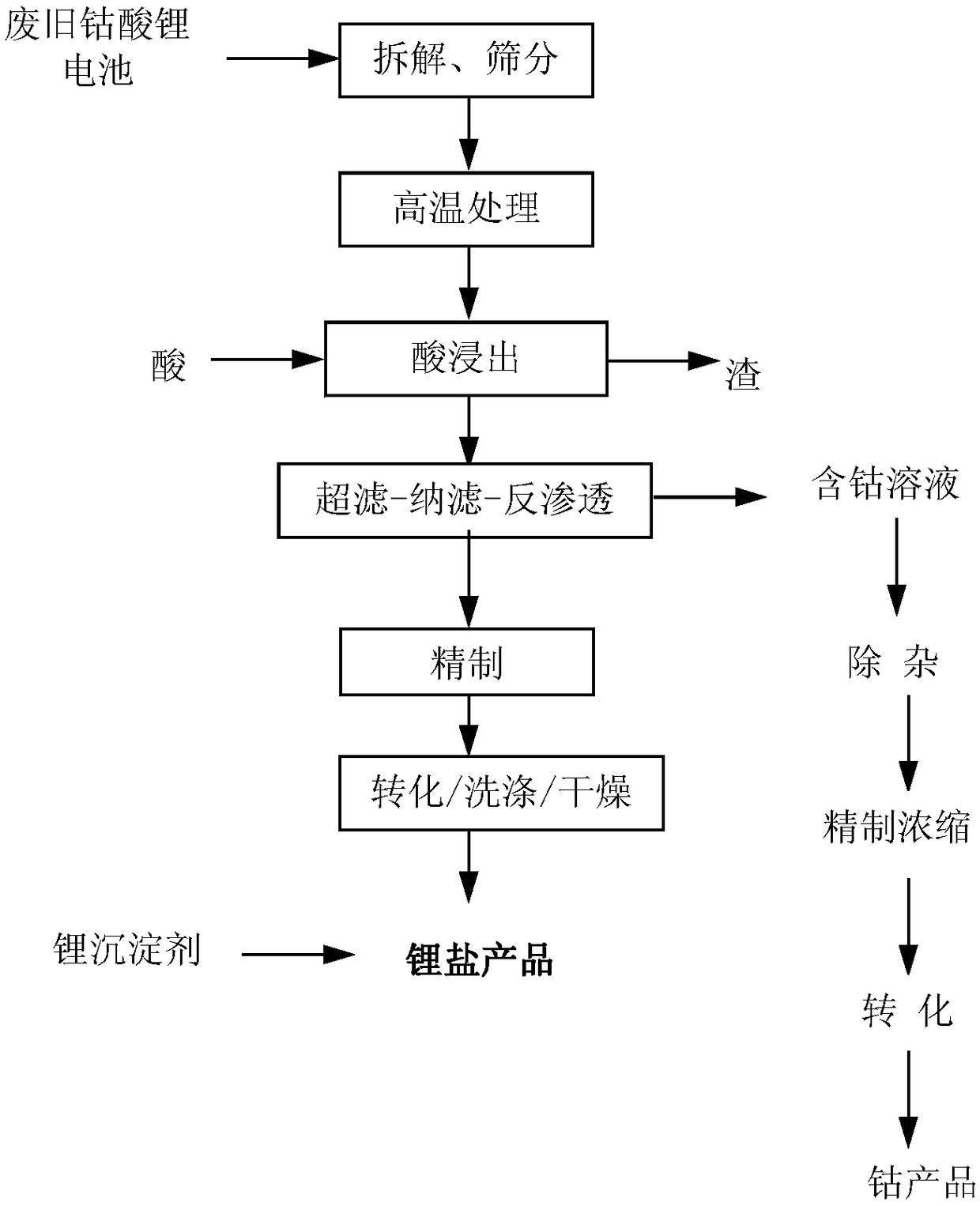A method and system for recovering lithium and cobalt from spent lithium cobalt oxide batteries
A technology for recovering lithium from old lithium cobaltate, applied in battery recycling, recycling by waste collectors, recycling technology, etc., can solve the problems of bacterial culture, harsh use conditions, complex operation of ion exchange method, and high cost of organic solvent stripping, etc. Achieve the effects of eliminating the use of organic extractants, high product purity, and easy control of process conditions
- Summary
- Abstract
- Description
- Claims
- Application Information
AI Technical Summary
Problems solved by technology
Method used
Image
Examples
Embodiment 1
[0087] A certain type of waste lithium cobalt oxide battery is used as raw material. Firstly, the waste batteries are discharged, disassembled, and screened to obtain positive electrode materials. Weigh 800g of lithium cobaltate positive electrode material and treat it in a muffle furnace at 450°C for 2h, then remove the binder, quench it with water and process it in ultrasonic vibration for 30min, so that the positive electrode material and aluminum foil are peeled off. The large mesh screen is used to remove and separate the aluminum foil, and the aluminum foil can be directly used for aluminum smelting after washing. The obtained black fine slag was treated with 4mol / L sulfuric acid, and 30% hydrogen peroxide was added at the same time, the solid-liquid ratio was controlled to 80g / L, the temperature was controlled at 80°C, and the leaching solution of valuable metals was obtained by filtration. The acid leaching residue is mainly acid-insoluble matter such as carbon powder...
Embodiment 2
[0095] A certain type of waste lithium cobalt oxide battery is used as raw material. Firstly, the waste batteries are discharged, disassembled, and screened to obtain positive electrode materials. Weigh 600g of lithium cobalt oxide positive electrode material and treat it in a muffle furnace at 650°C for 2 hours, then remove the binder, quench it with water and process it in ultrasonic vibration for 30 minutes, so that the positive electrode material and aluminum foil are peeled off. The large mesh screen is used to remove and separate the aluminum foil, and the aluminum foil can be directly used for aluminum smelting after washing. The obtained black fine slag was treated with 10mol / L sulfuric acid, and 30% hydrogen peroxide was added at the same time, the solid-liquid ratio was controlled to 80g / L, the temperature was controlled at 30°C, and the leaching solution of valuable metals was obtained by filtration. The acid leaching residue is mainly acid-insoluble matter such as...
Embodiment 3
[0103] A certain type of waste lithium cobalt oxide battery is used as raw material. Firstly, the waste batteries are discharged, disassembled, and screened to obtain positive electrode materials. Weigh 1000g of lithium cobalt oxide positive electrode material and treat it in a muffle furnace at 500°C for 1 hour, remove the binder, quench it with water, and process it in ultrasonic vibration for 60 minutes to peel off the positive electrode material and aluminum foil. The large mesh screen is used to remove and separate the aluminum foil, and the aluminum foil can be directly used for aluminum smelting after washing. The obtained black fine slag was treated with 4mol / L sulfuric acid, and 30% hydrogen peroxide was added at the same time to control the solid-liquid ratio to 75g / L, and the temperature was controlled at 85°C and kept stirring for 4 hours, and then filtered to obtain the leaching solution of valuable metals. The acid leaching residue is mainly acid-insoluble matte...
PUM
 Login to View More
Login to View More Abstract
Description
Claims
Application Information
 Login to View More
Login to View More - R&D
- Intellectual Property
- Life Sciences
- Materials
- Tech Scout
- Unparalleled Data Quality
- Higher Quality Content
- 60% Fewer Hallucinations
Browse by: Latest US Patents, China's latest patents, Technical Efficacy Thesaurus, Application Domain, Technology Topic, Popular Technical Reports.
© 2025 PatSnap. All rights reserved.Legal|Privacy policy|Modern Slavery Act Transparency Statement|Sitemap|About US| Contact US: help@patsnap.com



